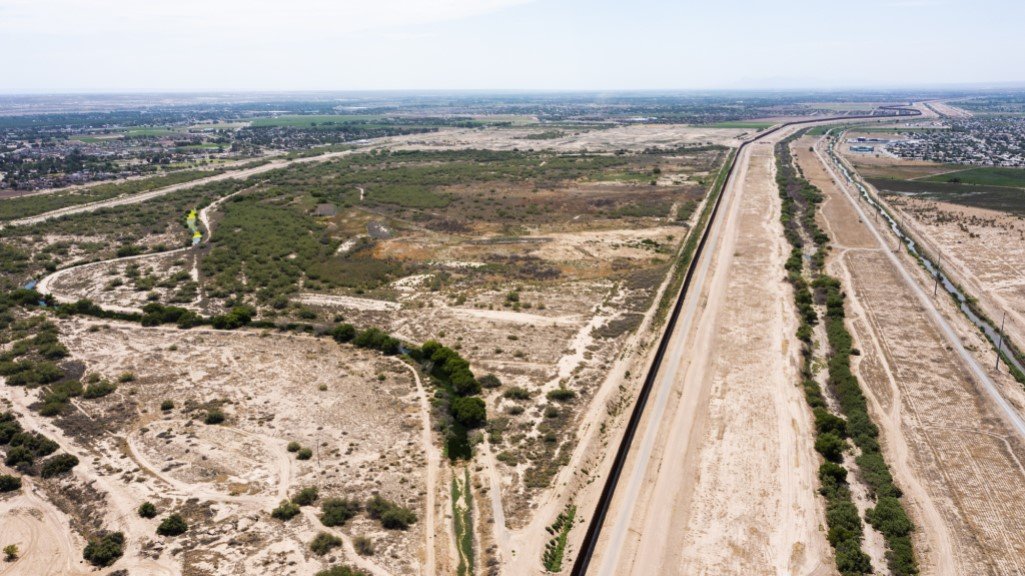Water is critical to restore the Rio Grande ecosystem at Rio Bosque

Editor's note: This story comes from the El Paso Times as part of the Puente News Collaborative, a group of newsrooms -- including ABC-7, which explores issues with a bi-national perspective. Story by Martha Pskowski.

Rio Bosque Wetlands Park manager John Sproul opened the spigot of a collapsible water tank in the bed of his pickup truck. Sproul and his colleague Sergio Samaniego filled buckets to water saplings they had planted last winter in the park on El Paso's south-eastern edge.
It was early June and the Goodding willows and Rio Grande cottonwoods were parched. But if the plants could just survive a few more days, they would make it.
Rio Bosque surrounds what was a bend in the Rio Grande until the meandering river in El Paso was straightened and channelized in the 1930s. The bend went dry and native vegetation died off. Since the late 1990s, staff and volunteers at Rio Bosque have restored water flows to the old riverbed.
UTEP, El Paso Water, the International Boundary and Water Commission, and the El Paso irrigation district work together to deliver water to Rio Bosque and sustain the growing wetland.
Slowly but surely, Rio Bosque is restoring a semblance of the Rio Grande wetland that flourished a century ago. The efforts are bearing fruit: 260 bird species have been seen in the park and native vegetation is resurging.
Rio Bosque is one of several initiatives reclaiming the importance of biodiversity and natural ecosystems along the highly-engineered Rio Grande. After the river leaves the Upper Valley, border infrastructure restricts access through central and southeast El Paso County. Rio Bosque is one of the few places where El Paso residents can experience a Rio Grande habitat. But as drought and climate change hit the Chihuahuan Desert, keeping the water flowing in river ecosystems is only getting harder.
After a dry, hot spring and delayed water deliveries, Sproul was counting the days until the trees would get water.
"This year has been a reminder it will always be difficult to have water for environmental uses," Sproul said, in between hauling buckets. "We expect we will have good years and bad years... But how do we ensure water is still there to meet environmental needs?"
Engineering projects transformed Rio Grande ecosystem
Starting in 1848, the Rio Grande formed the boundary between the U.S. and Mexico. But the river’s course shifted with springtime floods and sometimes dried altogether, causing border disputes and confusion.
The United States and Mexico signed the Rio Grande Rectification Treaty in 1933, agreeing to straighten the river from El Paso to Fort Quitman. The natural river meandered over 155 miles — the channelized river would be 85 miles. Levees were built on either side of a 100-foot-wide river channel. Rectification established the permanent border, improved irrigation and reduced flooding. But the project had unintended consequences.
Channelization and dam construction ended seasonal floods that were essential to the lifecycle of native plants, mammals and fish. Of the 18 native fish species originally found between New Mexico's Caballo Dam and El Paso, only eight survive today, according to historian Joanne Kroppe’s research. The Rio Grande silvery minnow's range is now limited to a small section of the Rio Grande upstream of Elephant Butte.
Cottonwoods and willows along the river suffered because floods no longer dispersed their seeds. In turn, birds that nested in the trees, like the Western yellow-billed cuckoo and the Southwestern willow flycatcher, died off. Invasive salt cedars spread.
“(They weren’t) thinking through, ‘What will this do to the fish? What will this do to the soil?’ That wasn’t really on their minds,” said Kropp, who wrote her doctoral thesis at UTEP on the Rio Grande rectification project. “Engineering-wise it’s quite an accomplishment. But it completely altered the natural environment.”
The Rio Grande’s disappearing wetlands were part of a national trend. A 1990 report to Congress found that by the 1980s only 104 million acres of wetlands remained in the lower 48 states. That was an estimated 53% decline from the 1780s. The same report estimated Texas had lost 52% of its wetlands in two centuries.
Federal policy in the second half of the 20th century, including the 1972 Clean Water Act, began protecting wetlands. But factors including sea level rise, climate change and urban development continue to threaten wetlands. While the rate of wetland loss has slowed significantly since the 1970s, the most recent national inventory still found a net loss of wetlands between 2005 and 2009.
Water access shapes Rio Bosque's future
The city of El Paso took ownership of the parcel known as Rio Bosque in 1973 and more acreage was added to reach its current size of 372 acres. Various agencies considered creating a wetland at the site. The idea didn't stick until the 1990s when the International Boundary and Water Commission (IBWC) took the lead and worked with the nonprofit conservation organization Ducks Unlimited to create a wetland at Rio Bosque.
UTEP signed an agreement with the city for its Center for Environmental Resource Management to manage the site and the IBWC began building the wetland in 1997. Sproul was hired as Rio Bosque's first manager.
It’s a struggle every year to get enough water to Rio Bosque. But 2022 has been especially hard. The park relies on a combination of groundwater from wells, treated wastewater and irrigation water.
El Paso Water delivers treated wastewater from the Roberto Bustamante Wastewater Treatment Plant, directly north of Rio Bosque, during the winter months. In the months leading up to farming season — typically February, March and April — the irrigation district claims that water and Rio Bosque relies on water from its four wells.
Since 2017, the park also has water rights for 348 acres of irrigable land. El Paso Water bought the rights from the irrigation district and allocated them to Rio Bosque for 25 years.
“Environmental stewardship is really important to us,” said Gilbert Trejo, El Paso Water’s interim chief operations officer. “We don’t see water supply planning as just meeting urban water demand. The environment has water demand as well, so we’re trying to do our part in that.”
This year, the last winter water delivery was on Feb. 14 and the summer water delivery was delayed a month, from May to June. While they waited for water, Sproul and Samaniego devised solutions to keep the trees alive through a hotter and drier than average spring season. The groundwater levels at the park’s wells steadily declined. They used a rented water tank to quench the willows and cottonwoods during May.
Bustamante resumed pumping water to Rio Bosque on June 4. Then the first water delivery from the irrigation district arrived on June 13. Monsoon rains fell for several days. By the end of June, the dry sections of the old river channel were filling, and the wetland cells were receiving water. Birds returned to the willows; muskrats dove through the water.

Trejo said water deliveries were delayed because the irrigation district needed treated wastewater from Bustamante during May. Other water sources were unavailable because canals were still being cleaning following the wastewater main break on the West Side.
“This year the irrigation district was just really short on water,” he said.
Sproul said the water sources have transformed the park. But like any water resource in the desert, they are not guaranteed forever. As El Paso plans for future scarcity, Sproul advocates for water to continue flowing to ecosystems like Rio Bosque.
Trejo said the utility is committed to supporting Rio Bosque. El Paso Water is planning an expansion of the Bustamante Plant to handle increased wastewater volumes from El Paso’s growing East Side. Trejo said after the expansion there will be more treated wastewater to use for Rio Bosque and the irrigation district.
“The way we have done the water balance is that we don’t want to harm the deliveries of water to the Rio Bosque,” Trejo said.
El Paso Water signed a contract ensuring the water deliveries from the irrigation district will go to Rio Bosque for 25 years. But Trejo acknowledged that after the contract expires, the rights could be re-assigned to urban water consumption during periods of increased need.
“If you fast forward 25 years from now, things aren’t going to get better from a drought or water resource perspective,” Trejo said. “We feel is prudent to have another set of water rights for El Paso Water to use in the future if needed during a severe time of drought. Unfortunately, we would have to make that decision and we may have to decide not to deliver water to Rio Bosque.”
Once the water arrived in June, Sproul was relieved. He knew the willows and cottonwoods — and the birds that nest in them — would survive another year.
Wildlife returns to the Rio
Sproul described his role as making key interventions — like planting cottonwoods — and then letting nature take over. But he hoped certain species, like the Western yellow-billed cuckoo, would make it back to Rio Bosque.
The cuckoo announces itself with a guttural call, as if the grey and white bird with a distinctive yellow bill is clearing its throat.
“It’s one of the birds that we really focused on trying to develop some habitat for, in hopes that they would return,” Sproul said while standing alongside the old riverbed.
The bird migrates from Central and South America and nests in cottonwood and willow forests in the Southwest. But its population plummeted after dams and droughts destroyed much of its habitat. In 2014, the U.S. Fish and Wildlife Service listed the Western yellow-billed cuckoo as threatened under the Endangered Species Act.
Yellow-billed cuckoos returned to Rio Bosque in 2007. On June 27, the first yellow-billed cuckoo of 2022 was spotted at the park.
This spring a pair of Harris’ hawks built their nest at the park’s edge. Burrowing owls, Mexican ducks, black-crowned night herons and yellow-breasted chats are a few of the over 200 bird species spotted in the park, which has become a popular birding location.
Assistant park manager Sergio Samaniego listens intently as Sproul identifies birds perched in the willows and flying overhead. Samaniego grew up in El Paso and a field course in environmental science at UTEP set him on his current career path. They have to rise early to avoid the desert heat, but Samaniego said it beats a desk job.
"I've tried office jobs, but it's tough," he said. "Now I am trying to pick up all the knowledge that John has about the park."
The park is open to the public from dawn to dusk. Visitors can walk on the 0.6 mile Bosque Trail, the 1.5-mile Wetland Trail or the 2.4-mile Rio Trail. Staff host guided walking tours and the Friends of the Rio Bosque group supports the conservation efforts.
From Del Valle High School students to Tigua people of the Ysleta del Sur Pueblo, Rio Bosque connects area residents with native ecosystems of the Chihuahuan Desert.
Samaniego said many El Pasoans grow up unfamiliar with the region's ecology. Educating visitors to Rio Bosque is one way to change that.
"A lot of people don't even know we're here," he said.
Restoring ecosystems in the Rio Grande watershed
Tricia Snyder grew up near the Rio Grande on El Paso's West Side, wondering why the river ran dry most of the year. She went on to study water management and is now the Rio Grande campaigner for WildEarth Guardians, a nonprofit conservation organization.
She said water management has a role to play in ensuring communities up and down the Rio Grande have access to natural ecosystems. Instead of only prioritizing irrigation and municipal water use, Synder said decision-makers should ensure the right for the river to flow and sustain ecosystems.
“We have to think about rivers as living systems, not just as infrastructure to get water where we need it to go,” she said.
Rio Bosque is one of several places protecting and restoring ecosystems in the Rio Grande watershed. In El Paso's Upper Valley, the 52-acre Keystone Heritage Park includes a wetlands ecosystem. The Rio Grande Valley State Park, known as the Bosque, is a 4,300-acre protected area along the river through Albuquerque where cottonwoods and other native species grow. In San Antonio, New Mexico, the Bosque del Apache National Wildlife Refuge contains extensive wetlands and is known for snow geese and sandhill cranes. In Las Cruces, La Mancha Wetlands is managed by the non-profit Nuestra Tierra Conservation Project.
“Every community should have a chance to experience that,” Snyder said. “These sorts of habitat restoration projects can serve as little nodes across the river.”
Rio Bosque shows the devastating habitat loss along the Rio Grande during the 20th century is not irreversible. Public institutions are working together to keep the water flowing. But continuing the ecological come-back will require hard decisions as cities, farmers and conservation advocates have to divvy up ever-scarcer water.
Communities up and down the Rio Grande face similar dilemmas of how to fairly share water resources in an age of scarcity.
“A lot of folks on the ground are coordinating,” Snyder said. “But the hard truth is that there are no easy answers anymore.”
Staff writer Martha Pskowski may be reached at mpskowski@elpasotimes.com and @psskow on Twitter.


